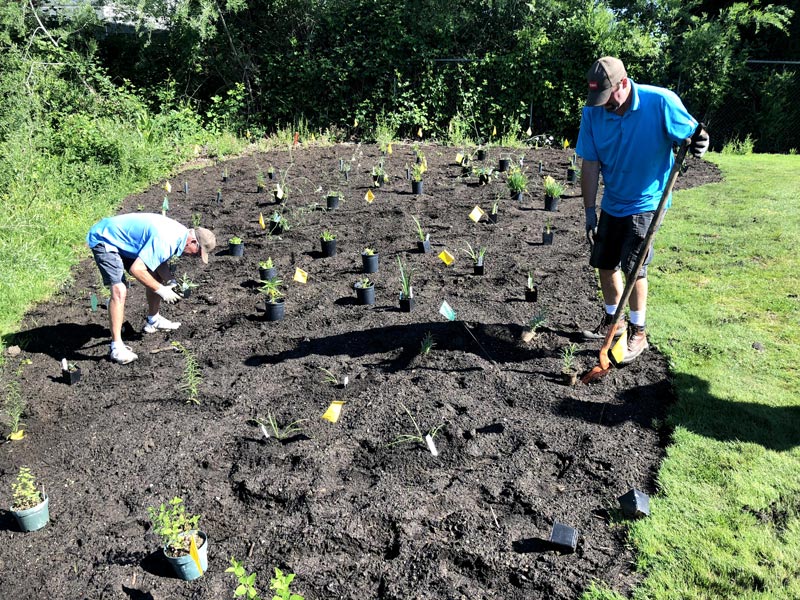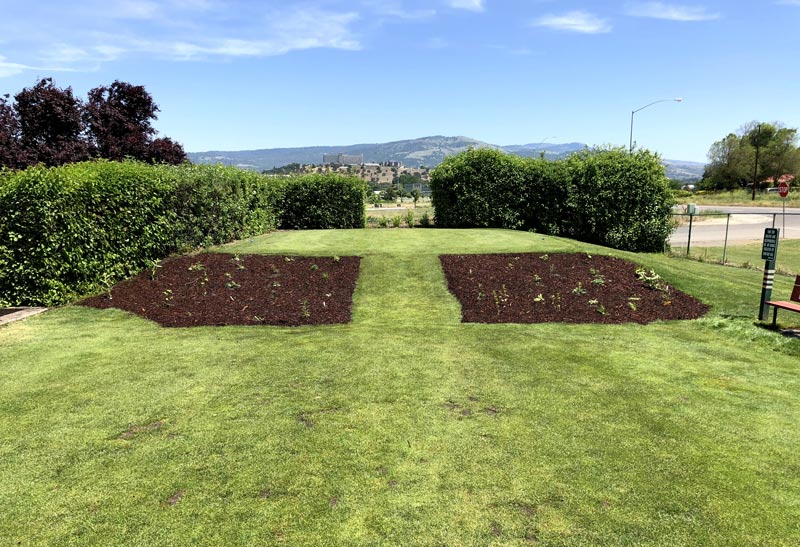
Suzie Savoie (left) of Southern Oregon Monarch Advocates and Josh Loy, Stewart Meadows Golf Course superintendent, plan plant locations for one of the five monarch waystations on the Medford, Ore., course. Photo by Robert Coffan
Josh Loy has become something of a celebrity in the Pacific Northwest’s pollinator scene.
Since Loy — Class A superintendent and a three-year GCSAA member — installed five monarch butterfly waystations at Stewart Meadows Golf Course in Medford, Ore., he and his course have been the subject of newspaper articles, TV spots and a podcast.
Through it all, Loy has stressed one thought: It’s all about the butterflies.
“It’s not for the notoriety,” Loy says. “It’s not about advertising for the golf course. We’re not trying to brag. It’s about being an advocate for the monarchs.”
There’s no dispute that pollinators — bees, butterflies and the like — have had a rough go. Some say the western monarchs have had it worst of all.
Arguably among the most picturesque of pollinators, monarchs in the United States are divided by the Rocky Mountains into eastern and western branches. The eastern monarchs migrate to overwinter in Mexico. Out west, monarchs generally overwinter in coastal California, then lay eggs on milkweed in spring from Arizona through Washington.
The overwinter population in central Mexico is said to have declined a staggering 80 percent since the 1990s; according to the Xerces Society for Invertebrate Conservation, western monarchs have declined by more than 95 percent since the 1980s.
Those numbers simply quantify what Loy had experienced.
He recalls growing up in southern Oregon. In summer, Loy would look on milkweed plants in a field near his parents’ home for monarch caterpillars, which he’d collect and “raise” in Mason jars. They’d hatch, and he’d release them to continue the cycle.
“It was something I took for granted,” Loy says, “and it made me think about my son.”
Tristyn was 13 at the time, and father asked son whether he’d ever seen a monarch in the wild.
“He said, ‘Yeah,’” Josh Loy recalls. “I said, ‘Are you sure?’ The way he said it, I took it that maybe he’d never seen a monarch in person. It made me think I wanted to do something to give kids a chance to experience what I had experienced as a child.”
Loy says plans began in March. He visited with Isaac Breuer, superintendent at Gustin Golf Course in Columbia, Mo., and subject of the 2016 GCM article Making a way for monarchs. Loy also consulted with Southern Oregon Monarch Advocates, primarily Robert Coffan and Suzie Savoie, about where to place his waystations and what to put in them.

Stewart Meadows Golf Course maintenance employees Ron Neely (left) and Brian Champion work on the monarch waystation near the No. 1 green. This waystation is the largest of five recently created on the course. Photo by Josh Loy
He ended up with about 240 plants, a mix of showy and narrowleaf milkweeds for the butterflies to lay their eggs on (milkweed is the only plant monarch caterpillars eat; when the milkweed is gone, so are monarchs), and various nectar-bearing flowers that bloom throughout the season — black-eyed Susans and columbines and lilies and irises and the like — upon which adults can feed.
“What convinced me was, we put color on the course,” Loy says. “There’s a lot of green out here. We don’t get a lot of color until fall, when half the trees start to turn color. But by implementing these waystations around tee boxes and places that are not necessarily in golfers’ play area, we added some color they can see but that doesn’t really impede the track of golf.”
The waystations are spread throughout the nine-hole course. They measure between 3,000 and 3,500 square feet combined and were a relative breeze to install.
“It was a simple process,” Loy says. “We had the means and the equipment.”
Loy says he budgeted around $2,000 for the plants and went over by around $500.
“The labor part ... I didn’t really factor that,” he says. “We’re here. If we’re not doing this, we’re doing something else on the course.”
From the start, Loy wanted to make sure his waystations didn’t become burdensome. Milkweed, after all, is a weed and grows like one.
“One thing we were concerned with, milkweed does spread rather rapidly by seed and rhizome,” Loy says. “Robert (Coffan) made us aware it will shoot up in grass where you don’t want it.”
The Stewart Meadows waystations are the only Monarch Watch-certified waystations on a golf course in Oregon. There are nearly 21,000 certified sites across North America, but certified waystations on golf courses are sparse to non-existent throughout the Pacific Northwest.
Their novelty drew a crowd to an official ribbon-cutting ceremony on Aug. 10. Among the 30 or so attendees were golfers, representatives from monarch organizations, Alexis Wenker — executive director of the Oregon GCSA — and representatives of media organizations.

The monarch butterfly waystation in Stewart Meadows GC’s eighth tee box. “This waystation has really taken shape today,” superintendent Josh Loy says. “The plants are much fuller and really give the tee box character.” Photo by Josh Loy
“Golf courses are given a bad name when it comes to these things because of the chemicals used,” Loy says. “A lot of people who are bee-friendly or monarch-friendly look down on golf courses. This is a good way to get a handshake between the two.”
There was at least one other remarkable guest of honor at the waystations’ ribbon-cutting.
“That morning, my mom found a caterpillar on one of the milkweeds,” Loy says. “Everybody was surprised we already had a caterpillar. That Monday, the 13th, one of our grounds crew guys found a monarch, and Robert went out to check and found she had laid some eggs. It’s doing what we had hoped it would do for monarchs.”
Andrew Hartsock is GCM’s managing editor.